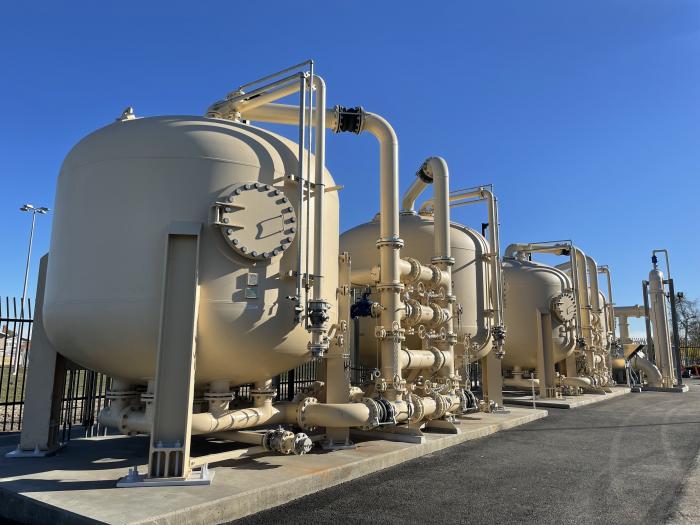Water Quality
-
 Lead Service Line Inventory10/14/2024 - 08:21 AM
Lead Service Line Inventory10/14/2024 - 08:21 AMGarden Grove has completed the Lead Service Line Initial Inventory (LSLI) required by U.S. EPA’s Lead and Copper Rule Revisions (LCRR). The deadline for the LSLIs is October 16, 2024. Through completing a historical records review and field investigations, Garden Grove has determined it has no lead or galvanized requiring replacement service lines in its distribution system. This includes any privately-owned or customer-owned service lines.
Garden Grove reviewed all applicable sources of information, including:
Available construction and plumbing codes to assess historical regulation of lead service line disallowance (e.g. National Lead Ban, State Codes, County Codes, the Codes and Standards of the incorporated cities before the statewide lead ban in 1986 including Garden Grove, Stanton, Santa Ana, and Westminster cities).
Water system records which indicate the service line materials, billing/customer data, historical capital improvement or master plans, and standard operating procedures.
Water distribution system records which indicate the service line materials, GIS data, distribution system maps and drawings, as-builts, meter installation records, work orders, inspections conducted during the course of normal operations including 2023 data with 35,495 records.
Other records such as the county parcel data.
In addition to reviewing the above sources of information, Garden Grove used an alternative method to develop the LSLI that was approved by the State Water Resources Control Board Division of Drinking Water on a case-by-case basis.
Garden Grove used stratified random sampling to develop the LSLI. Stratified random sampling involves physically inspecting a subset of randomly selected service lines in the distribution system. That subset is stratified or divided into groups based on certain characteristics (e.g., years the service lines were installed). Stratification allows for a sample or subset of service lines to be more representative of the service lines in the distribution system.
Garden Grove inspected 553 service lines on the utility-side, 1,682 service lines on the customer-side, and 295 service lines on both sides and the service lines were inspected non-lead. No lead or galvanized requiring replacement service lines were identified. After investigating a statistically significant subset of service lines, the remaining service lines were classified as non-lead service lines.
Garden Grove intends to document service line material information obtained from normal operations, such as service line maintenance, after October 2024 and will update the LSLI, as required by the State Water Resources Control Board Division of Drinking Water.
-
 Water Scam Alert8/21/2024 - 02:09 PM
Water Scam Alert8/21/2024 - 02:09 PMRecently, the Garden Grove Public Works Department has received reports of individuals going door-to-door within the city's service area falsely claiming there is a water quality issue. Their intention may be a marketing technique to sell a water filtration system or other water quality products and to gain access to your home. Community members are reminded to be diligent and to safeguard their homes and their personal information. Garden Grove's water meets all U.S. Environmental Protection Agency and State of California drinking water health standards. For more information, please call (714) 741-5276.

The City’s top priority is ensuring that the water we serve is reliable and meets all state and federal drinking health standards.
Like many communities throughout the nation, trace amounts of PFAS (Per- and polyfluoroalkyl substances) were found in our water supply after the state lowered the Response Levels for Perfluorinated Chemicals in drinking water.
PFAS are a group of man-made chemicals which have been manufactured and used in a variety of industries worldwide for more than 70 years.
In 2020, dozens of wells in Orange County, including Garden Grove were temporarily shut down and local water suppliers relied on imported water from Northern California and the Colorado River.
In collaboration with the City, the Orange County Water District (OCWD) designed and deployed treatment systems which filters PFAS from the groundwater. West Haven Well 21 is among 35 PFAS treatment facilities being designed and constructed in Orange County over the next two years. OCWD is funding 100% of the design and construction costs and 50% of operations and maintenance costs.
Garden Grove remains steadfast in our mission to provide sustainable water supply and exceed all state and federal drinking water standards and regulations.
Frequently Asked Questions
- What are PFAS?
- Where are PFAS Found?
- How did PFAS get into our water?
- How much of our water supply is affected?
- What Garden Grove and OCWD doing to treat and remove PFAS?
Per- and polyfluoroalkyl substances (PFAS) are a group of thousands of man-made chemicals, including perfluorooctanoic acid (PFOA), perfluorooctane sulfonate (PFOS) and perfluorobutane sulfonic acid (PFBS).
These chemicals are used to make carpets, clothing, fabrics for furniture, food packaging, cookware, and other materials to make them non-stick and/or resistant to water, oil, and stains. They are also used in a number of industrial processes and firefighting activities.
PFAS have been detected in the Orange County Groundwater Basin, entering primarily via the Santa Ana River (SAR) whose flows infiltrate into the basin. PFAS inputs to the SAR include treated wastewater discharges and stormwater runoff from upstream communities in San Bernardino and Riverside counties. Chemical manufacturers are the original source of PFAS chemicals. Despite playing no role in releasing PFAS into the environment, cities and water agencies must find ways to remove it from their local water supplies.
Orange County Water District (OCWD) and the water retailers it serves provide dependable drinking water that continually meets all state and federal drinking water standards. The state of California has established advisory levels for three PFAS compounds. In order to meet California’s advisory Response Levels for PFAS in drinking water, several dozen wells are impacted and future wells may be taken out of service. The loss of wells will impose unbudgeted costs on retail water agencies in OCWD’s service area that depend on groundwater for 77% of their supply. Agencies will have to temporarily purchase more costly imported surface water to replace PFAS contaminated supplies. The cost of purchasing imported water may place a burden on ratepayers of up to $20 per monthly water bill.
OCWD is proactively and swiftly addressing PFAS in the Orange County Groundwater Basin.
In December 2019, OCWD launched the nation’s largest pilot project to test 14 different types of treatment media, including granular activated carbon, ion exchange, and novel alternative adsorbents, with the goal of identifying reliable and cost-effective solutions to remove PFAS from water. Now in its second phase, the project will test additional adsorbents just emerging into the marketplace.
OCWD’s board of directors implemented a PFAS treatment policy that enables constructing treatment facilities for 11 currently impacted water agencies and bringing these treatment systems online within two years to restore the impacted drinking water supply. OCWD is funding 100% of design and construction costs, with operation and maintenance costs shared 50/50 with the retail water agency.
OCWD and 10 of Orange County’s public water agencies filed a lawsuit against 3M Company, E.I. DuPont de Nemours, Inc., DuPont de Nemours and Company, Chemours Company, Corteva, Inc., and DECRA Roofing Systems, Inc. for the manufacture and sale of PFAS that have contaminated groundwater, drinking water, and real property in Orange County. Through their lawsuit, OCWD and the public water agencies seek to protect ratepayers and ensure that the associated costs, including but not limited to treatment and replacement water, are borne by the companies that developed and manufactured PFAS.
Water Quality Report
2025 English
2025 한국어
2025 Español
2025 Tiếng Việt
Backflow Information
Backflow Testers List
Blank Backflow Report
Additional Resources
Water Quality FAQ's
Cross Connections FAQ's
2019 Public Health Goals Report
CDC Guidance on Reopening Buildings After Prolonged Shutdown or Reduced Operation
Additional PFAS Resources
OCWD PFAS Fact Sheet
State Water Resources Control Board
United States Food and Drug Administration
United States Environmental Protection Agency
Water Agencies in Orange County Initiate Steps to Protect Public Health
